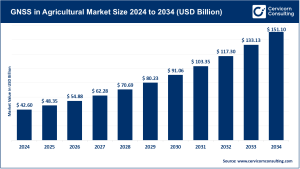Market Overview
The global agrivoltaics market—which integrates solar energy generation with agricultural land use—was valued at approximately USD 4.65 billion in 2024 and is projected to reach USD 12.26 billion by 2034, growing at a CAGR of 10.18%. By allowing dual use of land, agrivoltaics not only generates renewable energy but also enhances crop productivity and overall land efficiency. The market is particularly active in North America (35.8% revenue share) and Europe (29.2%), supported by strong solar irradiance and favorable regulatory frameworks.
👉 Get a Free Sample: https://www.cervicornconsulting.com/sample/2595
Key Market Trends
-
Dominance of Dynamic Solar Systems
Flexible, adjustable panels that track sunlight to optimize both energy output and crop growth accounted for 86.4% of market revenue in 2024. -
Shift Toward Monocrystalline Panels
Known for higher efficiency and durability, monocrystalline panels represented 56% of the market, reflecting growing preference for premium solar technology. -
Microclimate Benefits
Agrivoltaics help regulate temperature and humidity, enhancing yields for crops such as lettuce, berries, and tomatoes. -
Policy and Regulatory Support
Governments in the U.S., EU, and China provide incentives including subsidies, tax credits, and investment support to promote agrivoltaic adoption. -
Integration with Water Management
Solar shading reduces soil evaporation, while smart irrigation systems improve water efficiency—especially in arid regions.
Market Drivers
-
Increasing Renewable Energy Demand
Initiatives by national governments and private stakeholders are accelerating solar adoption to meet net-zero and climate targets. -
Land-Use Optimization
Dual-use systems allow simultaneous electricity generation and crop production, critical in regions with limited arable land. -
Government Incentives
Feed-in tariffs, tax credits, and public-private partnerships improve the economic viability of agrivoltaic projects. -
Climate Change Mitigation
Agrivoltaics provide renewable energy while shielding crops from extreme weather conditions. -
Water Conservation
Reduced soil evaporation and rainwater harvesting increase irrigation efficiency and support sustainable farming.
Impact of Trends and Drivers
The adoption of agrivoltaics enhances productivity in field crop applications and increases resilience in drought-prone regions. Technological innovations and supportive policies are driving deployment in Asia-Pacific, North America, and Europe, while large-scale agrivoltaic farms are becoming more common due to cost reductions and improved system design.
Challenges & Opportunities
Challenges:
-
High upfront capital costs.
-
Requirement for customized panel designs to suit different crops and land conditions.
Opportunities:
-
AI-driven energy optimization for enhanced output.
-
Modular and scalable panel systems.
-
Integration with vertical farming or precision agriculture for higher efficiency.
Future Outlook
The agrivoltaics market is expected to maintain strong growth, reaching USD 12.26 billion by 2034 at a CAGR of 10.18%. Emerging innovations such as AI-assisted solar tracking, climate-adaptive panel designs, and advanced water management systems are likely to further boost both land productivity and energy generation efficiency, making agrivoltaics an increasingly attractive solution for sustainable agriculture and renewable energy.
For a detailed market overview or company-specific insights, contact: Cervicorn Consulting


